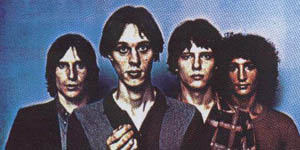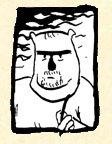The 100 Greatest Songs of the 1970s, Part VII.

070. Television “Marquee Moon”
(Tom Verlaine)
Marquee Moon, 1977
Almost thirty years ago, critics were groping for words like “angular” and “wiry” to describe Television’s sound, and no better descriptives have come along since. Although I still remember the way they were first described to me: as the Grateful Dead with all the blues leached out. Which makes them, in an odd way, more beholden to European classical music concepts than to the traditional rock & roll forms. This is their definitive track: a comopositional masterpiece without a hair out of place, Richard Lloyd’s guitar laying down a mesmerizing rhythm while Tom Verlaine’s guitar works increasingly complex patterns over top of it. There are lyrics, too, some kind of depressive beatnik ramblings, but they’re not the point (though Verlaine’s hipster yowl is about the only thing “punk” about the song; it’s an album-rock radio staple in a much cooler parallel universe). The point is the structure of the piece, the way it works inevitably, mathematically even, to a glorious crescendo — and after that, the most incredible sound, like fireworks or some kind of aural orgasm. Then the drums kick in with the motorik boom-chik again, and the train gets back on the tracks. Another verse, and it’s just about over. The structure, actually, is more or less the same as “Won’t Get Fooled Again” — but this is incomparably the greater song.
069. Nick Drake “Pink Moon”
(Nick Drake)
Pink Moon, 1972
One of the odd side-effects of the modern age of mp3s and the long tail marketplace is that the process of rediscovery often says more about the present time than the past. This isn’t really anything new: Moby-Dick was rediscovered and canonized in the 1920s because the 1920s needed Moby-Dick more than the 1850s had. Similarly, Nick Drake was virtually unnoticed during his lifetime, the age of singer-songwriters whose sensitivity was more or less a commercial venture; his rediscovery and canonization in the 1990s (where he could be seen as inhabiting the same level of uncertain beauty as Jeff Buckley, Elliott Smith or early Belle & Sebastian) said more about the needs of the 1990s than it did about the time when he lived — and died. Like Elliott Smith and Jeff Buckley, he died early and meaninglessly. Which is part of the charm, no doubt; music nerds sometimes seem to prefer a closed discography to those works still in progress (like Dylan or Costello today). This song was chosen, and I’ll be frank about this, because it was used in a car commercial and that’s how I became aware of it, and of Drake, and of his work. It was the first song I knew by him, and because I’m not a Drake obsessive (yet), it’s still my favorite, an immensely hushed scrap of fragile completeness. Whatever that means.
068. Harry Chapin “Taxi”
(Harry Chapin)
Heads & Tales, 1972
Sometimes you’re more critical when the artist sets a very high standard; anyway, that’s what I tell myself during the lazy, lazy rhymes “didn’t say anything more” and “a sad smile just the same.” Never mind what VH1 says, Chapin is one of the few musicians really worthy of the title Storyteller: his songs are almost always little dioramas of morality, longing and loss. And his sound-sculpturing was never less than brilliant, using what was really a quite small band to sound like a full studio orchestra, getting just about any cinematic effect he could ask for. The rhythm of this story is familiar — teenage lovers meet again years later to find that their youthful dreams both failed and came true in bittersweet irony — but he manages to place the telling little details that spark it to its own unique kind of life: the dress wet in the rain, the giveaway name on the license, the gate and the fine trimmed lawns. Not to mention the strange fantasy imagery on the bridge, which seems to come out of another song entirely (and the weird, keening lines by his bassist, Big John Wallace) but which dovetails beautifully with the finale. It would be a tough-luck story worthy of Hemingway, O’Hara, or Fitzgerald if it weren’t for the final couple of lines, which transform it into a post-Sixties comedown: Ken Kesey or Hunter S. Thompson with more dignified grace and wry humility.
067. The Damned “Smash It Up, Parts I & II”
(The Damned)
Machine Gun Etiquette, 1979
The milquetoast’s punk anthem. First you get two minutes of gorgeous pointillist electric drift, with Algy Ward’s sludgy bass keeping it real while the guitars and drums swirl in soft-rock fantasias, and then, finally, 1:59 deep into the song, do we get anything resembling a buzzsaw attack. But even that’s just amphetamined glam, T. Rex with no time to waste, not the dark, jagged noise the Damned made their name playing. For a band that pretty much accidentally became the first UK punk-rock group, this is some awful sissy stuff, the destructive nihilist lyrics delivered with an audible grin, even when Vanian unleashes the bottom-register “demonic” voice during the middle eight. Apparently the song is something of a tribute to Marc Bolan, who died in the summer of 1977, just late enough to declare himself the Godfather of Punk (his final, brilliant pop masterpiece, “Celebrate Summer,” makes the case exquisitely); and it works beautifully for that. It works beautifully anyway, without the backstory, and any pop lover who thinks punk isn’t worth their time needs to hear it, like, yesterday. Yeah, the Damned cut the first UK punk single (“New Rose”), the first UK punk album (Damned Damned Damned), toured the US first, had the first serious membership rift, and became the first punk dinosaurs in the 80s, but it was this moment, and specifically this song, when they decided to bleed in other rock genres, that their ghoulish, snarky version of punk became interesting.
066. Genesis “Firth of Fifth”
(Genesis)
Selling England by the Pound, 1973
This may have been the first time I bought an album, uh, sound unheard; I hadn’t heard any of it on classic-rock radio, no one I knew had ever heard any Genesis; I just read a review (Starostin’s, if you must know) and decided it sounded good. So an important step in my musical education, sure, but it deserves the spot for other reasons too: despite the extended, and extremely pretentious, instrumental suites, it’s structurally a decent little pop tune, with some of Peter Gabriel’s best meaningless-folderol-that-adds-up-to-visionary-poetry. I get the sense that Tony Banks’ opening piano sketch is trying to evoke Beethoven, but doesn’t have the melodic muscle for it and ends up somewhere closer to Grieg; or maybe it’s just the firth in the title that makes me think of the composer of the Norwegian fjords. Regardless, the entire song — Gabriel’s lyrics, the sweeping faux-majesty of the instrumental passages, all of it — makes me think of tales of Northern ocean voyages in the age before steel or gunpowder, of dawn over a white, calm ocean, of tantalizing glimpses of green mountains through the fog, the sight of a naked albatross sailing overhead, tempests that threaten but do not drown, and of the sparkle and wonder of the unearthly Aurora Borealis, a sight vouchsafed only to a chosen few. That’s what I think of; but I was young when I first heard it, and more romantic than I am today.
Next: 065-061. >>

No comments:
Post a Comment